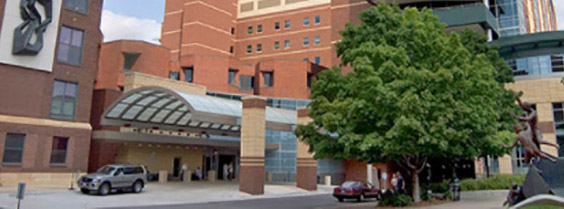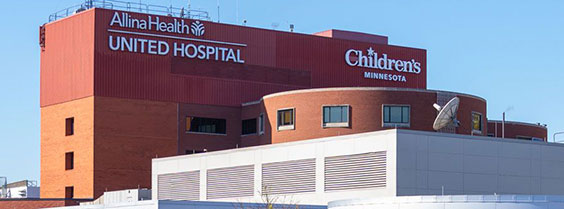
Center for Valve & Structural Heart Disease
Comprehensive Heart Care Centers
Valvular Heart Disease
- Valvular heart disease is common, affecting over 10 million people in the U.S.
- Symptoms may be heart failure, chest pain, or lightheadedness.
- Once symptoms develop, survival becomes impaired and is worse than many advanced cancers.
- Life-saving therapy can now be performed with very small incisions, and very low risk.
- Patients also may receive their valve therapy without general anesthesia, and be able to leave the hospital after a short stay (often less than three days).
Center for Valve and Structural Heart Disease
The Center for Valve and Structural Heart Disease at Allina Health Minneapolis Heart Institute® at Abbott Northwestern Hospital and Allina Health Minneapolis Heart Institute® at United Hospital are world renowned. We evaluate our patients in a dedicated clinic, using a multidisciplinary, heart-team approach.
Our team provides world-class care for a broad range of diseases affecting the cardiac valves and structural heart lesions. Patients benefit from expert evaluations that include advanced cardiac imaging with echocardiography, magnetic resonance imaging (MRI), and computed tomography (CT). A multidisciplinary approach enables the delivery of the most innovative transcatheter and surgical therapies for treating valve and structural heart disease, including investigational approaches that are provided at only a few centers in the world.
State-of-the-art therapies available:
Clinical trials
Patient stories
How are you feeling?
We play on New Years Eve here. And I wasn't going to do it this year, because I felt so rotten.
I think I'll pass.
When you get a certain age, you're supposed to take what comes and be happy and thankful. I wasn't as thankful until I realized how lucky I am.
You've got to take turns. I like you.
I had no symptoms until I was about 87. I started having this huh. When I was going up and down the stairs, I couldn't breathe. Then I got lightheaded, and I got terribly, terribly tired. Years ago, my doctor said, live with it. Ah, it was not living. It was existing.
I like the fact I'm independent, and I ask very little of my kids. If I can do it myself or get it done, I do. I really thought it was going to go away, until I was laying on the steps, and I knew that that wasn't going to go away, that something had to be done.
[MUSIC PLAYING]
There are some patients who simply want a chance at feeling better. And Miss [? Vaughn ?] was one of those. She had persistent symptoms, and the symptoms just were not getting better. She had a problem with her mitral valve that could not be treated with medicines.
We found out what was wrong, that this valve is not working properly, and that--
These two leaflets are meant to come together, like a pair of doors. When they close, they're supposed to touch. This mitral valve is allowing blood to move backwards.
But you've got to face facts. I am old. I don't think my body would take surgery well at all.
What I told her was that open surgery was not recommended for her, because of her age and the risk of the surgery. And it was very apparent to us that she was somebody who we should treat with the MitraClip therapy. A patient needs to be seen by a surgeon and a cardiologist together.
There's a large population of these patients that are not good surgical candidates. So a lot of that age plays a role into it. And so that increases our risk exponentially. One way to remove that risk is through a therapy like MitraClip.
[MUSIC PLAYING]
Our goal is to go in there and use that clip to help put those two leaflets together. Are you ready to get this done? OK.
And he said, don't worry. You're in good hands. It's a good crew.
So here's our room. Everyone has concerns about an elderly person having the procedure. But the procedure itself is so well-tolerated. It doesn't require going on bypass. The procedure is performed using access through a small vein in the patient's leg.
I think we're ready to go in and [INAUDIBLE].
This leaky valve causes pressure to build up. And that high blood pressure in this chamber then leads to heart failure. So this is the MitraClip. The clip is inserted into a patient fully closed. We then cross into the heart and use the clip arms in the grippers to then ground the mitral valve leaflets. We close the arms together, and then that's how we create the MitraClip implantation. It then turns a valve that has a leaky problem into a valve that now the leaflets come together. When we're done, that tube is removed, and it's close with either one or two stitches.
Congratulations, everyone. That was fantastic.
The leaky mitral valve has completely been treated with placement of this clip. And we're not causing any symptoms of heart failure.
[MUSIC PLAYING]
Hi.
Congratulations.
It worked.
It worked. Those pressures in your heart were life-threatening.
I'm a tough old lady. He was standing there smiling from ear to ear, and I knew it had gone really well. Just generally feeling better, and it feels lighter there, like something was lifted off my chest.
Fantastic.
She had the procedure done within about an hour. Within an hour and a half or so, she already had the breathing tube taken out and was already awoken, and was starting to recover at that point.
I'll see you in the morning, OK?
Overall, she was actually home about 48 hours after she came in for the procedure.
He had said I would feel better, and I did. That's the difference. I'm living now. I'm doing anything and everything I want, going where I want. I do do things differently now. I am doing yard work where I wasn't doing any. If I hadn't had the procedure, then I'd a ended up in a nursing home.
See how many times I go up and down the stairs?
Oh my, she's just showing off.
I'm just glad I'm still in my own home, and I'm driving at night. So it can be done. I'm a very lucky young lady, or an old lady, as you want to put it. And I feel very special. I really do.
[MUSIC PLAYING]

